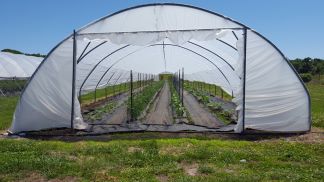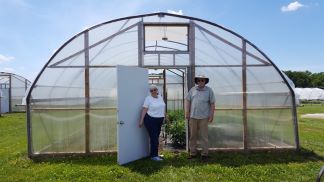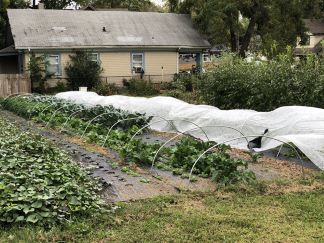The Four Season Garden
Back to Vegetable Agent Articles
Fall is officially here and the temperatures are getting noticeably cooler. The first frost in Johnson County usually comes around October 23rd which is when most annual fruit and veg plantings will succumb to the cold. If you’re like me you’ve probably already started to yank out some of the more tender summer crops that you had cared so dearly for over the last few months. And although some hardy plants (e.g. leafy greens, broccoli, root crops) will survive a few cold snaps, their days are numbered once exposed to hard freezes.
But if you’re committed to growing beyond the normal limits of our climate, there are many season extension techniques that will support plant growth almost year-round. One of the most simple and cost effective methods is building your very own “low tunnel.” These temporary structures rely mainly on evenly spaced arch shaped wire/pipe frames, built from bent metal or plastic covered with tightly fastened clear plastic sheeting for capturing maximum heat. The same structures can also be used with light weight frost blankets, shade cloths and insect netting.
Commercial growers in the Midwest have increasingly adopted similar albeit larger structures known as high tunnels or hoop houses, coveted for their ability to create microclimates, specifically warmer air and soil temperatures. More broadly, both low and high tunnels, create a “controlled environment” where a grower can protect plants from weather, pests and disease. In contrast to greenhouses, tunnels do not require a permanent foundation and the crops inside are often grown in ground. These simple structures rely largely on passive solar heating and generally cost less to construct.

A three-season high tunnel at the K-State Olathe Horticulture Center with tomatoes, cucumbers and squash inside. The plastic covering on three-season tunnels is removed before winter each year.

A four-season tunnel with end wall framing and polycarbonate panels for growing year round.
Low tunnels are the garden-scale way for a home grower to sustain their own crops through the fall and winter. They can be adapted for small and large in ground plantings, raised beds and containers. They can extend your harvest for plants already established in the late summer (e.g. broccoli, cabbage, carrots, etc.) and allow for later planting dates into the fall—especially for quick maturing leafy greens like herbs, spinach, lettuce.
Building your own an be very simple. One low-cost/easy DIY method uses standard smooth wire (9 or 10-gauge) bent to make arches/hoops. After inserting about 6 inches of the wire ends into the soil, a hand-bent six foot section can cover 4 ft of bed width at approximately two foot peak arch height. This type is more suitable for short term frost protection using lightweight fabric row covers (like the white ultraviolet-stabilized polyester covers manufactured by Reemay and Agribon) that’s because wire hoops will not easily support excessive wind pressure or heavy snow experienced during long-term winter use. Clear plastic sheeting is not recommended in the fall, because it can overheat, especially if you’re not able to vent the tunnel, i.e. open and close, on a regular basis.

Low tunnels used for protection on a variety of crops at the Young Family Farm in Kansas City, MO.

Bent conduit arches cover hardy crops like collards for extended harvest.
For gardening thru the winter a low tunnel built from metal or plastic pipe (like conduit or PVC) will be more durable. The standard hoop is 4 to 6 feet wide and approximately 40 inches tall at the center. There are low cost benders that help achieve good arch uniformity. Budget 10 to 14-foot wide row cover or clear plastic sheeting to cover the hoops. Sand bags, landscaping staples, loose soil, rocks, etc. serve as weights to keep sides secure but are easy enough to lift at a moments notice. Get more design details from our friends at Washington State Extension.
New England Farmer, Elliot Coleman, Author the Four-Season Harvest, experiments with planting hardy crops in early October, using fabric row covers until mid-November and then covering the fabric with an added layer of clear plastic sheeting. This double layer has the potential to promote growth of longer maturing cold season crops throughout the winter and allow for harvest in spring. We’ll be doing some experimenting of our own this year and look forward to sharing our results!
Zac Hoppenstedt, Horticulture Small Farms Agent
Have questions? The Garden Hotline is staffed by trained EMG volunteers and Extension staff who will assist you with questions.
Phone: (913) 715-7050
Email: garden.help@jocogov.org